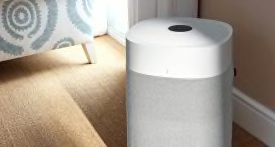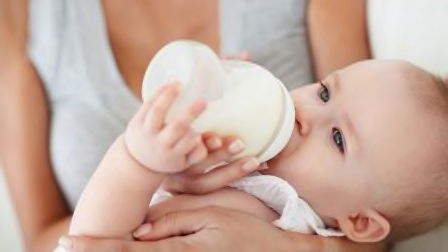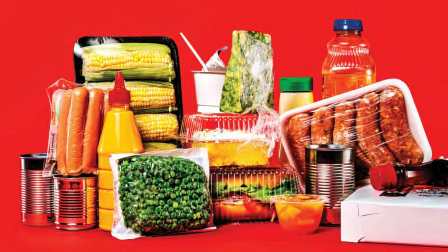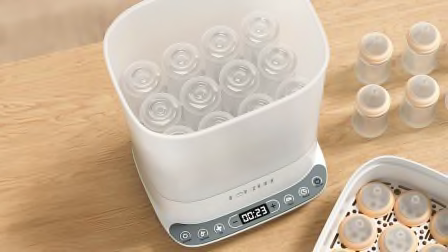How to Choose the Best Baby Bottle
Babies can be picky. So we asked 40 parents to evaluate baby bottles from Tommee Tippee, Philips Avent, Dr. Brown's, Comotomo, and more.
When you shop through retailer links on our site, we may earn affiliate commissions. 100% of the fees we collect are used to support our nonprofit mission. Learn more.

As soon as parents-to-be start researching baby registry items, they hit a very common challenge: choosing a baby bottle. There are so many bottle brands, materials, nipple flows, features, price ranges, and packages, that finding the right one can be one of the most confusing decisions a parent has to make when buying for a baby.
Certain baby bottles can be tougher or easier to work with. Some are easy to clean and can go in the dishwasher. Some are easier than others to break. Some last for just one baby while others stand up to multiple siblings. Bottles can come with colic and gas prevention features that some parents swear by, while other parents really don’t want to deal with a ton of tiny parts that can leak or get lost.
Tommee Tippee Closer to Nature Baby Bottle
Price: $6
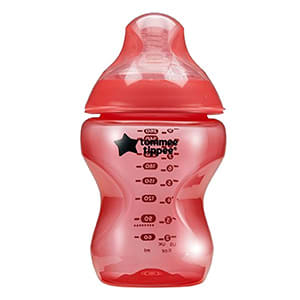

Pros: Simple to use with few parts, a wide opening, lightweight, easy to clean, clear measurement markings.
Cons: Occasional leaking.
Tommee Tippee was one of two clear winners, with parents giving it the top score in each major category: ease of use, filling, and cleaning, and ease of holding for the baby. A 35-year-old mom in Ohio said: “We chose Tommee Tippee for several reasons. The major reason was that our son gravitated towards that nipple type. It also had good reviews, and the slowest flow was suggested to help with nipple confusion while breastfeeding.”
Another Ohio mom, age 33, appreciated the company’s customer service. “They sent me a total of six bottles as samples!” she said. “Three of the bottles were traditional and the other three were anti-colic. My son immediately latched onto the bottles without any trouble.”
“Both bottle types were easy to disassemble and clean and put back together,” she continued. “Another reason I prefer these bottles is because my son is now 15 months and we are still using these same bottles. The longevity of the bottles has been spectacular!”
Tommee Tippee Closer to Nature bottles have a lightweight design, according to the parents we talked with, and a short, easy-to-hold shape. Multiple types of cleaning tools work with the bottles because they have a wide opening at the top. “It’s anything but difficult” to fill, one parent said.
Parents also liked the obvious measurement lines, and leaking was reported as rare.
Material: Plastic
Size: 5 oz., 9 oz., 11 oz.
Nipple flow rates: Extra slow, slow, medium, fast.
Philips Avent Natural Baby Bottle
Price: $10
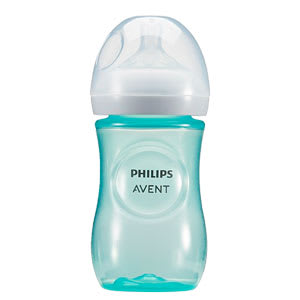

Shop: Amazon, Target
Pros: Simple to use with few parts, a wide opening, lightweight, easy to clean.
Cons: Nipple durability and discoloration.
One Arizona parent concluded that it was her baby who decided this was the best bottle. For the mom’s part, she liked that the Philips Avent Natural Baby Bottle “wasn’t too complicated” to clean. Another parent found that using this bottle was the most like breastfeeding.
Parents gave this bottle 5/5 in each of the categories we evaluated. Some of the main benefits included a lightweight and simple design without too many parts, an easy cleaning process, and a wide opening. As a 32-year-old Texas dad shared: “The bottle is way easier to fill than other models because of its wide lid and minimal simplistic thread design. Filling doesn’t require a super-steady hand, and unscrewing requires just the right amount of pressure to secure the liquid and allow for easy opening.”
According to the parents in our study, the nipples for these bottles might discolor or otherwise degrade, but replacing them is easy enough.
Material: Plastic
Size: 2 oz., 4 oz., 9 oz., 11 oz.
Nipple flow rates: 0m+, 1m+, 3m+, 6m+.
Lansinoh Baby Bottle
Price: $7
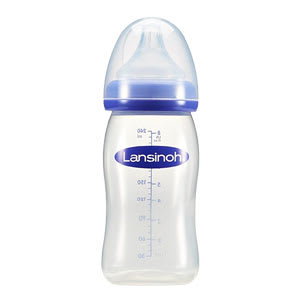

Pros: Simple to use with few parts, a wide opening, lightweight, easy to clean, clear measurement markings.
Cons: Inconsistent nipple flow rate, limited availability in stores.
The Lansinoh bottle scored 5/5 for all aspects of parent testing except for ease of holding for the baby, which was a 4/5. For parents who use Spectra pumps and bottles, one mom noted that the nipple seemed similar, so it was an easy transition back and forth. Another mom, a 26-year-old in Wisconsin, said, “I loved that they were highly recommended for their natural breast shape.”
Parents appreciated the simplicity and minimal parts, the wide opening that’s easy to clean, and the clear measurement markers. Some weren’t sure of how consistent the nipple flow rates were and weren’t thrilled about how hard these bottles could be to find in stores. But with reports of leaking rare, and a “tight seal,” as one dad put it, the Lansinoh is a baby bottle to consider.
Babies who are ready to hold a bottle themselves (6 months and up) might do well with this bottle. “My baby is still pretty young,” one mom said. “He definitely wants to hold it and has started trying more to hold it on his own. I think he likes the smoothness of it. The circumference size also gives him a good surface area to put his hands on. But because he is so young, I hold it most of the time to make sure he gets enough milk.”
Material: Plastic
Size: 5 oz., 8 oz.
Nipple flow rates: Slow, medium, fast.
Comotomo Baby Bottle
Price: $12
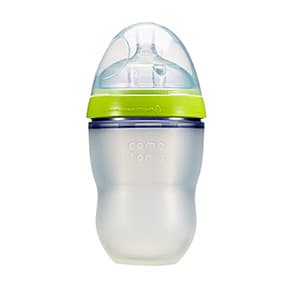

Pros: Soft silicone material, simple to use with few parts, a wide opening, lightweight, easy to clean.
Cons: Measurement markers have no contrast, limited options for nipple flow rate, occasional leaking.
Parents gravitated toward the Comotomo bottle in part because it resembles a breast and, for a baby, might be closer to the experience of breastfeeding. No hard plastic here, but the flexible material can be a bit less steady when you’re filling the bottle up or transferring milk. “When I transfer from one bottle to another, the shape of the bottles is a hindrance and leads to spillage from the edges,” said a 41-year-old California dad. “That can be highly frustrating because breast milk is liquid gold.” Another dad said: “The feeding part is easy, but the bottle assembly is actually pretty difficult. The nipple ring is very prone to getting cross-threaded on the bottle.”
Overall, parents were happy with the ease of use and cleaning but rated the ease of filling a 4/5. When transferring liquids into these bottles, put a bowl or other container underneath to catch spills.
Once the bottle is filled, one Utah mom said older babies would be excellent at feeding themselves because the material and shape are comfortable to hold “and squish with their adorable baby hands.”
Material: Silicone
Size: 5 oz., 8 oz.
Nipple flow rates: Slow, medium, fast, variable.
MAM Easy Start Anti-Colic Baby Bottle
Price: $6


Pros: Wide opening.
Cons: Many parts and pieces, occasional leaking, no measurement marker for 1 oz.
Parents might know the MAM brand from its popular line of pacifiers. The MAM Easy Start Anti-Colic Bottle ranked below the others above, with a 5/5 in the filling process but a 4/5 for all other factors. Parents of colicky babies reported positive results for its anti-colic features, while other parents appreciated the realistic nipple shape to help breastfeeding babies latch and drink more easily.
“We needed anti-colic since she was a gassy/uncomfortable baby, one Georgia mom said. “I enjoyed the larger bottle for holding in my hand. Also the larger capacity for milk. She liked the shape of the nipple and took to it.”
“I knew I wanted to breastfeed and go back-and-forth between [the] bottle,” a West Virginia mom said. “I read really great reviews about babies being able to take the nipple and go back to breastfeeding with ease.”
But some parents warned that there are a few parts that require disassembling, which could be confusing to new parents who might try to wash them assembled. Others noted that the parts come with “a lot of steps.” So read the manual on this one, but give it a go.
Material: Plastic
Size: 5 oz., 9 oz.
Nipple flow rates: Extra slow (Level 0); slow (Level 1); medium (Level 2); fast (Level 3); extra-fast (Level 4).
Dr. Brown’s Natural Flow Anti-Colic Options+ Bottles
Price: $8
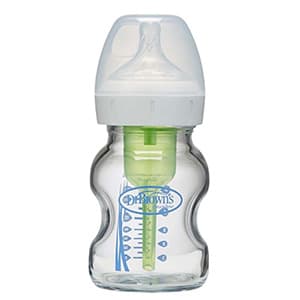

Pros: Wide opening, clear measurement markings.
Cons: Many parts and pieces, occasional leaking.
If you want to try a glass bottle, this is a great option to consider, according to the parents in our study. These bottles have a wide opening and clear, durable measurement marks. Some parents warned about occasional leaking and said there were too many parts. But when one caregiver, age 32, tried multiple nipple types in a sampler pack, this bottle was the one that prevailed.
“I chose Dr. Browns because the anti-colic option was important to me, especially with my first baby,” a Louisiana mom said. “I didn’t know what to expect and wanted to be sure I was prepared if she was a gassy or colicky baby.”
According to participants, filling is easy but cleaning could be an issue. “These bottles have a lot of pieces because of the anti-colic insert, which can lead to a buildup of a lot of dishes in the sink,” the 24-year-old Louisiana mom also said. “You have to take the scrub brush and clean the tiny holes on the air vent insert to clean the inside of them, and that can be difficult. But having the vent pays off in the long run.”
A parent in Colorado said: “The hardest parts to clean are the anti-colic inserts that are green. Since they go from wider to a narrow straw opening, it’s hard to get a bottle sponge in there.”
With heavier glass bottles, be prepared to wait a bit longer for babies to have the strength and fine motor skills to maneuver the extra weight successfully. One mom shared that it was an issue, though another said both her kids could do it easily by 8 months old.
Material: Glass
Size: 5 oz., 9 oz.
Nipple flow rates: Preemie (0m+, slowest flow); Level 1 (0m+, slow flow); Level 2 (3m+, medium flow); Level 3 (6m+, medium-fast flow); Level 4 (9m+, fast flow); Y-Cut (9m+ fast flow/thick liquid).
Price: $8
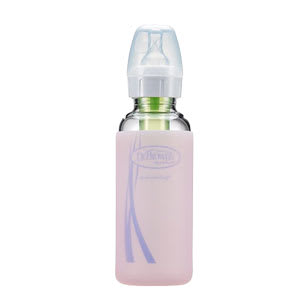

Pros: Clear measurement markings.
Cons: Many parts and pieces, occasional leaking.
Parents loved this bottle, but some babies might struggle. Filling it was simple (it got a 5/5 rating), but some parents ranked it lower (3/5) for being a bit more difficult for their baby to hold. These bottles might be slightly harder to fill than some others on the list, with a bit of a narrower opening, and one parent noted that some formula powder would sometimes miss the opening. One even said they kept a funnel around for improved milk transfer. But a NICU mom said the extremely accurate measurements made the bottle a must-have.
If you opt for this bottle, save more time for cleaning because there are numerous parts. One parent was concerned about bacteria hiding in the parts because the anti-colic functions were a bit more tedious to clean.
Material: Glass
Size: 4 oz., 8 oz.
Nipple flow rates: Preemie (0m+, slowest flow); Level 1 (0m+, slow flow); Level 2 (3m+, medium flow); Level 3 (6m+, medium-fast flow); Level 4 (9m+, fast flow); Y-Cut (9m+ fast flow/thick liquid).
What to Look for in a Baby Bottle
We asked parents to share what factors were most important to them in choosing a baby bottle, and what they wished they had known about baby bottles before starting to use them. We also asked Elizabeth Meade, MD, for her take as a lactation consultant and pediatrician. Here’s what they suggested prioritizing in your baby bottle search:
Nipple Size and Flow Rates
This one is a really important choice, especially if a parent is also nursing as well, according to Meade. “Most important is the flow/nipple size,” she says. “Most breastfed babies will do fine with a newborn or even a preemie nipple, even as they get older. A faster flow may be harder for a very young infant to handle and may contribute to bottle preference as the baby gets older. And a faster flow means the baby doesn’t have to work so hard to get milk, and that can lead to avoidance of nursing directly, which often has a slower flow of milk.” She also says that if a baby is solely bottle fed, don’t rush them up to a faster flow than they need. “This can also contribute to overfeeding and mask the baby’s natural cues about hunger vs. satiety.”
Parents we talked with noted the impact of nipple size and flow rates on feeding, and the need to regularly replace nipples as babies grow. “I didn’t realize most bottle brands sell the nipples individually and that they had different milk flows,” said a 33-year-old mom in Michigan.
Bottle Size
“Most babies will do fine with 4-to-5-ounce bottles for the duration of their feeding experience, especially if they are taking breastmilk,” Meade says. “I always recommend parents start with this size, or they can use even smaller 2- to 3-ounce bottles for newborns if desired.”
“Some infants may need to size up to 6 to 8 ounces as they get older,” she says. But it’s not necessary to upsize to a larger bottle, which she said may contribute to overfeeding. Meade encourages parents to allow babies to guide how much volume they need without worrying if they finish a bottle: “Many caregivers may feel the baby needs to finish the offered amount, so they keep trying to encourage the baby to take more even if the infant is giving cues that he or she is full. We should remember that babies don’t need to be in the clean plate club.”
Anti-Colic Features
Parents generally wished they had more knowledge about anti-colic features and how they could help with feeding problems like gas and discomfort. “I wish I knew more about the anti-colic piece and how it worked. I’m still confused about it,” said a 41-year-old mom in California.
Leaking
Many parents were surprised about leaking from some bottles or because of certain designs. “I wish I knew that some models leak more than others,” as one 32-year-old dad from Texas put it.
Ease of Cleaning
The cleaning requirements surprised some parents, particularly for bottles with intricate designs or multiple parts. “I never thought to think about the cleaning aspect when first looking at bottles,” said a North Carolina mom, age 30.
Ease of Use
Many parents highlighted bottles with fewer parts as being easy to use, assemble, and clean. Simplicity in design was often tied to better usability for caregivers in our study. While some bottles were intuitive to assemble, others required more of a learning curve, particularly those with anti-colic components. Simplicity and ease of use were important in a baby bottle, especially for parents whose babies spent time with other caregivers, such as family members or child care providers.
Ease of Filling
Parents said they liked the wide openings and clear measurement markings for simplifying the process of bottle feeding, while narrow openings and spillage posed challenges. Narrow openings meant the need for scoops, funnels, or careful pouring from storage containers, especially for families using formula.
Materials
Just over 60 percent of study participants rated bottle material as important or very important. While some parents preferred glass for its resistance to chemical leaching, plastic bottles were appreciated by others for being lightweight and travel-friendly. The flexibility of bottles made with silicone and their ease of use also stood out.
“Parents should choose what works best for them, but many families are making a dedicated effort to limit plastic given exposure to microplastics,” Meade says. “And since a baby’s entire diet for the first several months is comprised of breastmilk and/or formula, it is important to consider how we are storing and serving.” There are glass options as well as bottles that are plastic on the outside and have a silicone liner inside. “These can be fantastic choices for parents wanting to minimize plastic exposure.”
Baby’s Preference
Ultimately, no matter how much research you do on baby bottles or how many you buy, your baby will make the final decision. Parents who participated in our study emphasized that it’s a trial-and-error process to find the right bottle. Most mentioned experimenting with multiple ones. While some discovered the ideal bottle quickly, others tried six or more types.
Meade adds that although choosing a bottle can seem like a big decision, try not to stress too much. “The only critical thing is to find a bottle that your baby takes well and that works for your family and your priorities,” she says.
Baby Bottles With No Detected BPA, Lead, or Phthalates
When it comes to baby bottles, materials matter. See what CR’s tests revealed about the safest baby bottle options.











